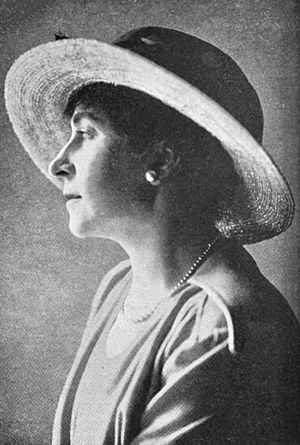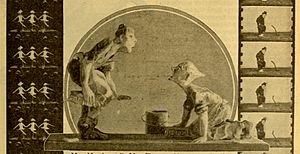Helena Smith Dayton facts for kids
Quick facts for kids
Helena Smith Dayton
|
|
|---|---|

1917 portrait of Helena Smith Dayton
|
|
| Born | 1883 |
| Died | 1960 (aged 76–77) |
| Nationality | American |
| Known for | Animation |
|
Notable work
|
Romeo and Juliet (1917) |
Helena Smith Dayton (1883–1960) was an American artist. She was a filmmaker, painter, and sculptor who worked in New York City. Helena was one of the very first people to use stop motion and clay animation techniques. She started experimenting with these methods in the 1910s and 1920s. She was also the first American woman to try clay animation.
Her "clay cartoons" were often funny. Helena was even featured in special "Humorist Salons" in New York City. Besides her art, she spent time in Paris during World War I. There, she managed a YMCA canteen for soldiers. Helena was also a published author. She wrote everything from news articles to plays and even a guide to New York City.
Her Creative Work
Art and Animation
Helena Dayton started sculpting around 1914. At that time, she lived in Greenwich Village in New York City. She once said her fingers "itched" to mold something while she was writing. So, she bought art clay and began to sculpt. She wanted to create funny versions of people she saw.
Her unique, funny figures appeared on magazine covers. They also went with her humorous short stories in magazines like Puck. Helena made clay models of famous people. She called her work "gigglesome bits of statuary." She even copyrighted some of her creations. These were sold as "Caricatypes" for 75 cents each. Girls dressed as Dayton's caricatures appeared in the Ziegfeld Follies of 1916. Helena wrote the lines for them.
Helena began trying "clay cartoons" in 1916. An article in Popular Science Monthly in February 1917 talked about her new "animated sculpture." The article showed photos of Helena with her clay figures. It also showed pictures from her animated play Battle of the Suds. There was even a film strip showing dancing chorus girls and a man with a snake. The writer thought the animation was "startingly realistic and highly amusing."
Later in 1917, Helena said it was hard to know how much to move an arm or head. She wanted to avoid jerky movements. She learned to make smaller changes to her figures. Helena created 16 different poses for her sculpted figures for every foot of film. Sometimes, up to 30 figures moved in one scene. She could animate about 100 feet of film each day. She planned to release one film every month.
The first public showing of her animated shorts was on March 25, 1917. This happened at the Strand Theater in New York City. Later that year, she released her version of William Shakespeare's Romeo and Juliet. Before the animated part, the film showed Helena sculpting the clay figures.
She also made a short film called Pride Goeth Before a Fall. This film showed "dances and other stunts." It was part of Pathe’s Argus Pictorial "screen magazine" released on November 25, 1917. Another film with her clay figures around a banquet table was in the December 16 edition. By 1917, her art and animation had made her quite successful. She had about $12,000 in her bank account. This would be worth a lot more money today!
It's not clear if Helena made any more films after 1917. This might be because of World War I. She worked overseas during the war, which put her art on hold. Sadly, none of her films have been found yet. But we can still imagine her animation from the pictures and descriptions in old magazines.
After the war, Helena worked as a canteen director for the YMCA in Paris. She then created sculpted figures showing scenes from France. These were shown in an exhibition in 1922 in New York City. She was a member of the Society of Illustrators.
Later in her life, she started painting. She showed her paintings in 1943 at the Montross Gallery. A New York Times art critic praised her work. The critic said her portraits were "unflattering and sound," showing real individual character.
Writing Career
Before she became an animator, Helena Dayton worked as a reporter. She wrote for a newspaper in Hartford, Connecticut.
Helena co-wrote two guidebooks with Louise Bascom Barratt. These were A Book of Entertainments and Theatricals (1923) and New York in Seven Days (1926).
Later, she started writing plays. She often worked with Louise Bascom Barratt. In 1926, they co-wrote The Sweet Buy and Buy. This play was performed on stage in 1927 and also published as a book. They also co-wrote Hot Water, which opened in 1929 in New York City. In 1931, Casanova's Son, also co-written with Barratt, was first shown in New York City.
Her Personal Life
Helena Dayton was married to Fred Erving Dayton. He was a writer and publisher.
Sometime between 1920 and 1925, Helena Smith Dayton signed The Greenwich Village Bookshop Door. This special door was at Frank Shay's Bookshop. It was like an autograph book for almost 250 bohemians (artists and writers). The door is now kept at the Harry Ransom Center at the University of Texas at Austin. You can find Helena's signature on the first panel of the door.
Films by Helena
- 1917? Battle of the Suds
- 1917-03-25 Animated Sculpture (a program of short films), shown at Strand Theater, New York
- 1917-11? Romeo and Juliet (a 1,000-foot film reel)
- 1917-11-25 Pride Goeth Before a Fall (part of Argus Pictorial No. 2)
- 1917-12-16 Argus Pictorial No. 3 (included a short film with figures around a banquet table)


